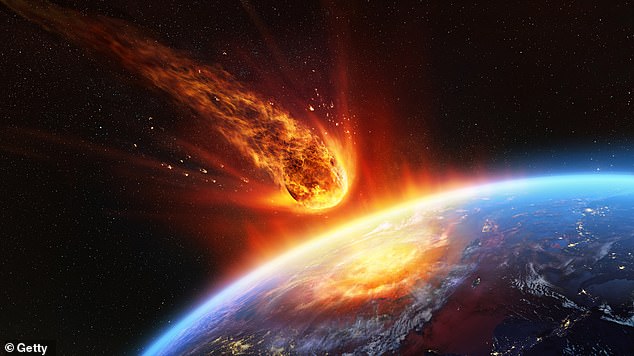Scientists have issued a chilling update on the ‘city-destroying’ asteroid due to make a perilously close pass of Earth in 2032.
While NASA has thankfully ruled out any chance of 2024 YR4 hitting the Earth, new observations using the James Webb Space Telescope (JWST) show that the moon is still in the firing line.
Researchers now say there is nearly a four per cent chance of this building-sized space rock colliding with the moon.
The new observations also show that the asteroid is even bigger than previously thought.
Based on ground-based observations, space agencies had initially estimated that 2024 YR4 was around 40 metres (131 feet) in diameter.
However, new direct measurements show that the space rock is really 60 metres (200 feet) in diameter – about the height of a 15-story building.
Were an asteroid of this size to hit the Earth, it would unleash a blast 500 times more powerful than that of the atomic bomb dropped on Hiroshima.
After it was discovered in December last year, the probability of an impact rose rapidly to an alarmingly high 3.1 per cent – the highest odds ever recorded for a large asteroid.

Scientists have given a chilling warning about the ‘city-destroying’ asteroid 2024 YR4, as a new study shows that it is even larger than expected (stock image)

Using the James Webb Space Telescope (JWST), scientists directly measured the size of 2024 YR4 and found that it has a diameter of 60 metres (200ft)
In February, the world’s space agencies warned that there was a serious chance that 2024 YR4 would hit Earth on December 22, 2032.
Although most experts expected the impact probability to fall towards zero as scientists refined their predictions, the situation was deemed serious enough that better observations were needed.
During this period of uncertainty, NASA made the ’emergency’ decision to grant an international team of astronomers access to the JWST.
Their job was to accurately measure the size of the approaching asteroid in order to work out how much damage 2024 YR4 could really cause.
Although Earth-based telescopes had predicted the asteroid’s approximate size, these were only rough estimates based on the light bouncing off the surface.
As the European Space Agency explained in a blog post: ‘In general, the brighter the asteroid, the larger it is, but this relationship strongly depends on how reflective the asteroid’s surface is.’
To get around this problem, the JWST used an instrument designed to measure the heat radiating off the asteroid in the form of infrared radiation.
On March 26, the JWST recorded the asteroid for five hours as it spun through space.

Unlike ground-based telescopes, the JWST uses an instrument which measures the heat radiating from the asteroid in the form of infrared radiation (pictured). This allows scientists to work out exactly how large the asteroid really is

The chances of 2024 YR4, seen here by the European Southern Observatory on February 25, hitting Earth remain at zero. However, there is still a slim possibility that it could hit the moon
The infrared data gathered in that time showed that 2024 YR4 was 60 metres in diameter, give or take seven metres, and was spinning on its axis once every 20 minutes.
At that size, if 2024 YR4 was still heading towards Earth, it would have been enough to trigger action from the United Nations-backed Space Mission Planning Advisory Group.
This group would have been responsible for working out whether a plan was needed to deflect the incoming asteroid and avert a city-destroying impact.
Dr Andy Rivkin, an astronomer from Johns Hopkins University and the principal investigator of the Webb Director’s Discretionary Time program, says this has given us a much better understanding of the asteroid.
‘We found that the thermal properties of 2024 YR4, in other words how quickly it heats up and cools down, and how hot it is at its current distance from the sun, are not like what we see in larger asteroids,’ he said.
‘We think this is likely a combination of its very fast spin and a lack of fine-grained sand on its surface.
‘We’ll need more data to say for sure, but it seems consistent with a surface dominated by rocks that are maybe fist-sized or larger.’
While the odds of 2024 YR4 hitting Earth remain at zero after these new observations, learning how to observe potentially dangerous objects could be key to humanity’s survival in the future.

This image shows the orbit of asteroid 2024 YR4 in purple with the sun in the centre and orbits of planets (Mercury = cyan; Venus = yellow; Earth = dark blue; Mars = red). On its current predicted path, there is a two per cent chance that the asteroid will hit the moon

If 2024 YR4, seen here from the Magdalena Ridge Telescope on January 18, does hit the moon it would be good news for scientists. The blast wouldn’t affect Earth but would allow astronomers to see a crater forming in real time
Dr Rivkin says: ‘We expect more possible impactors to be found in coming years as more sensitive asteroid search programs begin operation. Observations using the most powerful telescope we have right now are invaluable.
‘Understanding the best ways to use it and how to get the most out of its data is something we can do now with 2024 YR4.’
Likewise, if 2024 YR4 does hit the moon in 2032, knowing the exact size and composition of the asteroid could be a major boon for scientists around the world.
The blast wouldn’t affect Earth but it would be the first time scientists could watch a known asteroid create a lunar crater in real-time.
The data gathered from this impact could help scientists understand more about other craters on the lunar surface.
This article was originally published by a www.dailymail.co.uk . Read the Original article here. .

